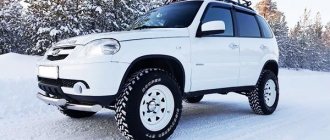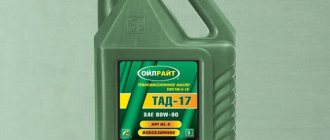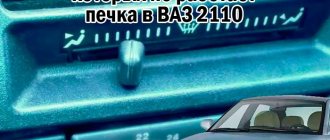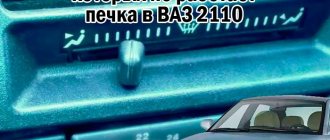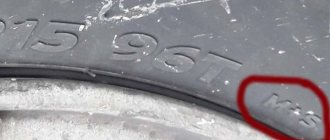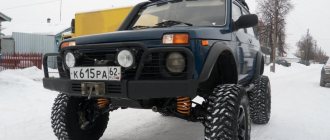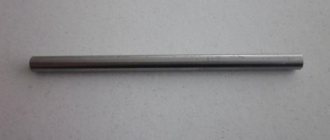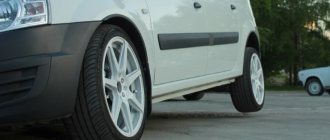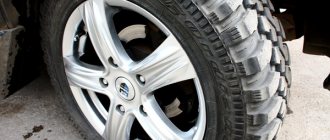Rubber provides traction between the wheels and the road and transfers engine power to the asphalt. It is important to choose the right kit for your car so that the operation of the car is as efficient as possible. Each set has such a parameter as the seasonality of the tires. Next, information will be presented about all-season tires, the features of their markings and the properties of this rubber.
In order to identify all-season tires by marking, such tires have an additional designation in the form of the letters M+S. The abbreviation Mud+Snow means that the kit provides reliable traction in difficult weather conditions. In addition, all-season tires are designated by the symbols 4S, AS or AW (4 Season, All Season or All Weather).
However, it should be understood that, in essence, all-season tires lose to winter tires at low temperatures and lag behind summer tires at high air temperatures. In fact, these tires are considered more of an off-season tire.
What is an all-season tire?
Various sets of seasonal tires are offered for the car, which differ in their characteristics and composition.
Winter tires are made of soft types of rubber, which will prevent the tire from becoming tanned. In addition, such products have a developed tread pattern and a high profile, which allows them to cling to slush and effectively drain water. The difference between summer tires is hard rubber. This tire tolerates high loads well and does not melt while driving, confidently clinging to the surface. The profile height is small, and the contact patch with the road is the most extensive. However, in low-temperature conditions it becomes dull and does not provide proper grip, which results in a long braking distance.
Finding out whether you have summer or winter tires is quite easy. Sets without any additional marks are considered summer. All-season tires are designated by the letters 4S, AS, M+S, and the Velcro or studded tires are marked with snowflake designs.
What is the difference between summer tires and winter tires?
Summer tires are much easier to choose than winter tires. In order to feel confident on the road, it will be enough to choose tires with a small percentage of wear. Therefore, you should choose these tires based on the size of the car’s wheels. Summer tires are also stiffer. For good road grip, it is better to choose soft tires. The smoothness and softness of the ride depends on this, which will be much higher. True, unlike winter tires, at high speed summer tires can lead to a large roll. For driving on the highway and at high speed, you should select medium-hard tires. For lovers of high speed and sports cars, hard tires are suitable.
Important: when changing tires, pay attention to the wheel alignment of your car’s suspension. This improves handling and helps avoid uneven tire wear and improves traction.
The main difference between summer and winter tires :
- Wear-resistant;
- Acceptable price;
- Which car they are best suited for.
The presence in tires of silicate, oil, starch and other substances that make the wheel more tenacious, improve contact properties on a wet road or make the rolling resistance coefficient low.
Low rolling resistance, which reduces fuel consumption.
Parameters and characteristics of rubber
Each set has a concept of tire seasonality. Despite the fact that tires of a certain composition are labeled as all-season tires, such a set is demi-season tires. These all-season tires have a softer rubber compound. In the summer, the all-season tire will overheat and “float,” which will lead to premature wear.
In the case of ultra-low temperatures, tires will lose to their winter counterparts. Such kits work most effectively at near-zero levels, providing proper grip on cold asphalt, slush or rain. In such conditions, rubber can be used, but you should not ride on it all year round; you should wear specialized shoes for the winter or summer season.
Tip 3. Price and quality
Based on the ratio of price and quality, all tires can be divided into three groups: branded, second echelon - often owned by leading companies, but a little simpler and cheaper, and, finally, products from factories that are just trying to conquer the market. The first category unconditionally includes tires from classic, well-known manufacturers. For example, Continental, well known all over the world. The latter are often sub-brands, once independent brands that have fallen under the wing of the tire giants. For example, Gislaved, now owned by the same company Continental. The third group includes Chinese and some domestic manufacturers, whose tires are increasingly approaching the quality of the second group. If the purchase budget is determined, then it is easier to navigate among these three groups. I recommend the “golden mean” - sub-brands of top tire manufacturers: their products are not much inferior in characteristics to tires of famous brands and are relatively inexpensive.
Pros and cons of operation
Each kit has its pros and cons.
All-season tires are no exception. Advantages:
- allow you to save money by purchasing only one set of wheels;
- feel good at zero temperatures, on wet or snowy asphalt.
Flaws:
- significantly lose to profile tires, subject to seasonality. At high temperatures the tire “floats”, and when the thermometer table is lowered, it becomes tanned. In winter the car must be on winter tires, and in summer - on summer tires.
Definition
Winter tires are a seasonal variety of tires designed for high-quality grip on the road surface at air temperatures of no more than minus five degrees. There are two most common types of winter tires: studded and friction. The tread of winter tires is also of great importance.
Summer tires are a type of rubber with clearly defined longitudinal grooves to drain fluid from the contact patches of the tread with the road surface, as well as with weakly defined transverse grooves and a complete absence of micropattern. Among other things, they have a smooth, rounded transition from the treads to the sidewalls.
Tire size
The tire size is also indicated on the sidewall of the tire. There is a European type of marking. For example, readings 205*35*R17 make it clear that the tire width is 205 mm, the profile height is 45, and the inner diameter is 17 inches. The letter r means that we are looking at shoes with radial cord weaving.
The American method is similar to the European one, only in front of the numbers there are additional letters that signal the “orientation” of the rubber (P – Passanger, LT – Light Track). There is another way to indicate the standard size, where the values are given in inches. For example, if there is a number 29*11*R18 on the side, its decoding will mean the following:
- 29 – outer diameter in inches;
- 11 – tire width;
- 18 – internal diameter.
Low and high profile tires
Each tire has its own designation on the side. This is the marking of tires for a car, but what does the marking on car tires mean? Car tire markings decoding:
235/75 R15 , where 235 is the width of the tire in mm, 75 is the percentage ratio of height to width, 15 is the diameter of the rim itself.
Advantages of full profile tires:
- great softness;
- designed for movement on uneven roads and dirt roads;
- help increase vehicle clearance.
Advantages of low profile tires:
- resistant to rough roads;
- pass any obstacles;
- light and less sensitive;
- soft and take on the main load when driving.
Disadvantages of high profile tires:
- slight loss of power;
- poor grip;
- small, but there is a deterioration in driving control.
Disadvantages of low profile tires:
- rigidity;
- small potholes and stones are felt on the suspension and the car as a whole. Larger rocks can even break the suspension or damage the vehicle.
Therefore, when choosing certain tires, be sure to focus on what time of year and what roads you will mainly drive on, so below we will look at how to choose summer tires for a car.
Speed index
Another required parameter is the speed index. This is a letter designation that indicates that the car can move at a given speed for several hours. The closer the letter is to the end of the Latin alphabet, the higher this indicator. Now the most common are kits with the indexes S, T, U, HV or W, allowing speeds of 180-190-200-210-240 or 260 km/h, respectively.
Where to begin
The vehicle's owner's manual usually contains some recommendations for the correct selection of tires. This takes into account the type of wheels (steel or alloy), season of use (summer, winter), as well as the standard factory size. Naturally, not every driver adheres to such recommendations, which is why the car may be equipped with tires that, in terms of their parameters, do not meet the requirements of the manufacturer.
So it’s better to start by studying the standard requirements for tires of a certain brand of car. If you are satisfied with the type and size of the tires that are installed on the car, you simply need to rewrite all the existing designations.
Load index
Along with the speed category, tire manufacturers put down two more numbers - the maximum load index. This parameter means that the tire is capable of traveling under the specified weight on one wheel, subject to maximum pressure. The indicator is indicated in kilopascals closer to the inner radius.
The higher the indicator, the greater the load that the wheel can carry. The minimum value in the industry is 1 - 46.2 kg per wheel, and the maximum figure is 279 - 13.6 tons per cylinder.
Differences in appearance
Rules for choosing all-season tires for a car
When it comes to the differences between summer and winter tires, first of all they begin to pay attention to the differences in road grip and the different chemical compositions of the rubber. But almost no one mentions external signs of difference, and many inexperienced drivers even say that they do not exist
Of course, it is quite problematic to immediately determine the external differences between summer and winter tires. However, this does not mean that they do not exist. Here are just the main signs of differences between tires in appearance:
Winter tires have a deeper tread. This is due to the fact that in winter there is often precipitation: rain and snow. The deeper tread provides improved traction on slippery roads. Very often, winter tires are equipped with special studs for driving in icy conditions.
Please note that not all winter tires have studs! But the main feature of difference is the drawing. And here we should mention in a separate line two options for studless winter tires: Scandinavian and European type
Each of them has its own characteristics in the construction of the pattern: European type. It is characterized by a diagonal pattern, where a network of channels for water drainage is developed (very reminiscent of the silhouette of a Christmas tree). Powerful lugs can be seen along the periphery of the rubber tread. Finally, another distinctive feature of the tires is the presence of a huge number of very thin sipes.
Scandinavian type. A sparse pattern with a large number of “checkers” in the form of a diamond will immediately catch your eye. They are arranged in a checkerboard pattern. You can also notice small stripes on the treads, which play an important role in the grip of the wheels on the road. And the last difference: there is quite a decent distance between the elements of the picture.
Marking
Sometimes the marking of all-season tires can be supplemented with various icons. Among the additional symbols you can find the inscription “Retread”. The fact is that some kits need to be repaired and the compound is re-fused onto them and the tread is cut. Refurbished products carry this designation. Driving on such tires does not pose any danger, but the tire purchased by the driver will wear out a little earlier. Fortunately, the price is cheaper.
Some car tires and wheels do not fit together, having fundamental differences in design. So, if you are going to change the tires of your car yourself, it is worth remembering that the tube sets must be installed on the corresponding wheels with the designations LK, GK or RK. The symbols LB, GB or RB indicate combination with tubeless type kits (TubeLess).
Tire installation rules regulate the presence of color marks. If there is a yellow triangle icon on the sidewall, then this is the lightest part of the rubber. All you need to do is align it with the mark on the disc. The red dot indicates the hardest point and should also be aligned with the L mark on alloy wheels.
Why do you need colored circles on your tires?
You've probably come across tires with colored circles on the sidewalls. There are many rumors about their origin, ranging from the fact that these are technological marks necessary only in the rubber production process, and ending with the fact that the manufacturer or seller marks a low-quality or defective tire in this way.
In fact, these multi-colored circles indicate the design features of the tire. The meaning of tires marked with yellow or red spots is as follows:
- yellow circle – the lightest section of the tire;
- red circle – the heaviest section of the tire;
- green circle - tires for initial installation on the vehicle at the manufacturer's factory
But why does anyone need to know where the easy part is and where the hard part is? It's simple! Typically for tires with tubes, the tire is mounted with the lightest area towards the nipple. This helps achieve perfect balance when rotating.
In some cases, on the sidewall of the tire you can find a marking consisting of a number in a circle, square, triangle, painted in white paint. This is a kind of mark that the product has passed quality control (like our quality control department). In addition, this mark indicates the specific controller responsible for the inspection.
Selection for SUV or crossover
We told you how to distinguish winter tires from summer tires - by the snowflake icon. However, to choose shoes for a non-trivial car, this knowledge may not be enough. When purchasing wheels for a crossover, you should imagine where the car will spend most of its time. If in the city, then standard tires with the designation AW (All Weather or Aqua - improved drainage and increased resistance to aquaplaning) are a good choice.
If the car goes beyond the definition of an SUV and you are planning trips into nature, then it is better to give preference to sets with a developed tire tread, improved lugs and increased cross-country ability. Such kits are designated by the letters AT - All Terrain.
For real off-road vehicles, special tires like Bridgestone Dueler are used, which have proven themselves in combat conditions and have high load resistance and excellent grip. This set is more expensive than the standard one, but its price is justified by its excellent qualities.
Tip 7. Place of purchase
At the market, in a specialty store, in a supermarket or online store with delivery - there is a wide choice. But there are nuances everywhere. There is a high probability of buying defective tires on the market that have been stored incorrectly. Supermarkets sometimes offer tires at very low prices, and if the tires have not been lying in stock for many years, you can buy them. But the choice of manufacturers and sizes is very limited. There is not much chance that you will find the model and size you need.
The date of manufacture is always marked on the tire. The first two digits are the serial number of the week of the year, and the second two are the year.
The date of manufacture is always marked on the tire. The first two digits are the serial number of the week of the year, and the second two are the year.
Online stores are convenient, but they will bring you a pig in a poke. You will see the production date, or even the country where the tires were made, only at the time of delivery. If you don't like it, you can refuse. The only pity is the time lost waiting for delivery. In addition, many online tire stores only operate on prepayment basis.
Specialized stores are good because you can inspect the product before purchasing, and if you purchase it, you can also change the shoes of your car for free or at a discount. This is perhaps the safest and most convenient purchase option.
After how many seasons do you need to change winter tires?
When buying new tires for winter, you should consider their service life. With moderate use, branded Velcro will last 3-4 seasons, after which, even with slight wear, it will be recycled due to the drying out of the rubber mixture.
A studded model also cannot be extended for 10 years. In terms of time, the modification lasts 2-3 years. Then most of the spikes fly out, and the wheel loses its initial grip and stability on the road. Additionally, the tread itself wears out. As a last resort, you can replenish the missing metal inserts, but it is not recommended to restore the tread itself.
Budget tires can withstand 1-2 seasons of intensive use. At the same time, the price tag differs by two or more times.
There is a set threshold for when you need to replace your winter tires with a new set. The remaining tread height must be at least 4 mm according to traffic regulations - this does not apply to tire models with installed wear indicators. The elements may be at a higher height, which is explained by the specific rubber composition or tread design. Some motorists ignore the signs and continue to drive further, but is it worth the risk on a snowy road - definitely not.
You can see what the wear indicators look like in the photo.
Mechanics of the experiment
We decided to measure the braking distance from two speeds - 80 and 40 km/h. The first option is emergency braking somewhere on the Moscow Ring Road in heavy traffic. The second is braking in the city. To evaluate the braking distance, we accelerated to 90 km/h and applied emergency braking in a strictly defined place - you literally need to hit the brake pedal and hold it until it comes to a complete stop. The difficulty is that this needs to be done at the same speed, in the same place. This is the only way to achieve repeatable results. A deviation of no more than 5% is allowed.
All measurements were carried out with a professional Racelogic V-Box device. He measured braking distances to within a few centimeters.
All about the design and seasonality of tires
First of all, let's figure out whether summer tires can be used in winter. To do this, let us once again consider in detail all the external distinctive features and markings that help distinguish tires with different purposes.
For a radial tire, the cords encircle the tread, while for a diagonal tire, they intersect
Structurally, tires are divided into radial and diagonal. The second option is now produced only in the cargo segment. Passenger tires are all radial, as indicated by the letter R - although many people think that this comes from the word “radius”.
The design can be tubeless - tube tires are most often, again, truck tires.
Differences between tube and tubeless tires
All other differences relate to the tread, since it is the working element of the tire surface. The main criterion for its formation is the operating conditions of the tire, and above all, the ambient temperature.
How to determine whether the tires in front of you are winter or summer, how to distinguish them? Very simple - along the tread.
Summer tread for asphalt
The so-called road tread is the main option for summer tires. They are additionally marked with the HP icon - from Highway Performance (translated as “efficiency on the highway”).
Or, depending on the manufacturer, there is an HT badge - from Highway Terrein, here a synonym is simply used, but the meaning is the same.
Summer tire designation
Attention: This tire is designed for driving on asphalt surfaces at positive temperatures, so by definition it cannot be a winter tire.
And don’t be fooled by the M+S (mud plus snow) icon, which we even see in the example photo. This just means that this tire has a deeper tread, which provides better off-season performance when the roads are often slushy.
The main requirement for HP tires is good grip on dry and wet asphalt and wear resistance.
As for the adaptability of tires to high-speed driving, several types of tread patterns are provided for this, which can be directional, while maintaining symmetry, or vice versa - be asymmetrical.
One of the tread pattern options
The structuring of the pattern, expressed in various ways of grouping grooves, blocks and lamellas, helps either to increase the speed when driving, or to improve the maneuverability of the car when changing, overtaking or when turning.
Note: These characteristics are most important for cars in the sports category, therefore these types of treads are used in the manufacture of tires in the corresponding sizes and are accompanied by either the sport prefix or the SP prefix.
In the absence of asphalt (dirt, especially wet roads), or for driving on snowy or icy roads, such tires are completely useless, so for the winter season they use other types of treads, and, most importantly, the rubber compound.
Features of all-season tread
The remaining types of treads, which are universal AT (All Terrein) and mud MT (MUD Terrein), can be used as on summer tires. Logically, there is no dirt in the cold, so winter protectors are for the most part universal.
They are designed for moderate off-road conditions, which are more suitable for the conditions of the winter season.
This is how deep the tread can be - a tire for mud
All winter tires have a so-called all-season tread, the distinctive feature of which is the increased depth of the grooves between the blocks. They are good for conquering off-road conditions, but for the car to feel good in winter, only a deep tread is not enough. The rubber, again, must have the appropriate composition.
All-season tires are something between summer and winter: the tread is for winter, and the rubber composition is for summer
With winter tires it is always deep, which makes it easier to move on loose or melted snow. Therefore, to distinguish all-season tires from summer tires, it is enough to pay attention to the tread depth.
For a pure summer road tire it is minimal, 4-5 mm. For all-season tires - and, accordingly, for any winter tire, the depth of the grooves is twice as large - at least 8 mm.
Tread depth on an all-season tire
Winter and summer tires: distinctive features
How do you know if the tires you have are winter or summer if they both have deep tread and no studs? Summer tires intended for off-road use, as a rule, do not have sipes at all - small hairy slits on the blocks.
HP tires have them, but in very small quantities. But winter tires have a lot of them, since it is due to them that the tire adheres more effectively to a slippery hard surface.
And on the surface of winter tires there are a lot of soft rubber fibers, which you won’t see on purely summer or simply all-season tires. So, you can identify summer tires not only by the inscriptions, but also simply by their appearance.
It is clear that when winter tires have studs or visible holes where they can be installed, this indicates their seasonal origin. However, there is also a non-studded tire, which can be distinguished from a summer tire only visually.
By the way, riding on spikes is generally prohibited in many countries. Besides Russia, it is driven only in Finland, Canada, Iceland and some other European countries. In the rest, even if they change their shoes for the winter, they put on a non-studded (friction) tire.
But even in those countries where there is no legislation regarding changing seasonal tires, in the event of an accident caused by ice, the damage is paid by the party whose car had summer tires.
Not everyone knows for sure whether it is possible to drive in winter on summer tires, and if not, then why. Apart from being inappropriate, this practice of fines is an excellent answer to this question.
Where there is no law on winter tires, this is how they get out of the situation
Note: our people are distinguished by their intelligence and ability to save money. In this regard, some manage to install winter tires on the front and summer tires on the rear. More often this is done forcedly - for example, the budget is not designed to purchase a new set.
But let's say right away - you can't do this. A more detailed answer regarding different tires on a car will be given a little later.
Winter friction tires, which people lovingly call Velcro, have equal rights on the roads with studded tires. In its production, special rubber compounds are also used, to which more natural rubber is added for softness.
It’s just that Velcro is used more in areas where there is practically no snow in winter. In Russia there are not so many such regions, but in European countries, if they change a summer tire, it is more often with a winter non-studded one.
Driving on winter tires in summer is just as irrational as driving on summer tires in winter. The latter, of course, holds the road well and resists aquaplaning well, but on dry asphalt it brakes much worse.
Due to the increased softness, which is so important at low temperatures, when heated, winter tires soften even more and therefore wear out very quickly.
Note: As for the summer tire, in the cold there is a feeling of tanning, during which it loses grip on the asphalt and directional stability. The braking distance becomes twice as long, which is why accidents with the first snow happen with such frightening consistency.
That is why even the place for testing models is selected not only by the quality of the test site, but also by the temperature of the area in which it is located.
Designation of winter tires
If you cannot visually distinguish winter tires from summer ones - for example, you do not buy a tire in a store, but a used one, you can look on the sidewall for the icon of a snowflake enclosed in a pointed triangle, like the one in the photo.
And also to the name of such tires, the manufacturer often adds the prefix winter (winter), or simply the letter W with which this word begins.
Badges on all-season tires - and besides M+S, these can be 4S or AS (all seasons), in principle, do not apply to winter tires. At least not for our winters. You can still drive on these tires down to -10 degrees, and at lower temperatures they harden just like summer tires.
The tire manufacturers themselves talk about the temperature up to which summer tires can be used. You can only ride on these wheels up to +5 +7 degrees Celsius; in colder weather, the risk of getting into an accident greatly increases.
How each type of tire is labeled
- the pictogram “snowflake against a mountain” means winter tires;
- sun - summer tires;
- the inscription AllSeason (AS) or AllWeather - all-season.
In addition, many manufacturers put the letters M+S (Mud + Snow) on the side of the tire. This means that the tires provide good traction in snow and mud. This designation can be applied to any tire, regardless of the season.
Advantages and disadvantages
What type of winter tires is best to use can be clearly determined by clarifying the advantages and disadvantages of studded and friction tires.
Advantages of rubber - “Velcro”:
- Good grip and directional stability on wet asphalt surfaces.
- No noise.
- The slats do not harm the road surface.
- When visiting one of the European countries with your own car, you may find that only lamellas are allowed on the territory of the country and the use of studs is unacceptable.
- At subzero temperatures, these tires have sufficient elasticity to ensure driving comfort and safety.
- They help reduce the consumption of the fuel mixture; fuel consumption is slightly less than when using studded tires, but more than on summer tires.
- No steering wheel vibrations.
- The operating period is longer than that of tires with studs.
Disadvantages of friction tires:
- Poor adhesion to ice or icy surfaces.
- Long braking distance on ice.
- Passability on snow is lower than that of studded products.
Advantages of studded tires:
- Good grip when driving on ice and snow.
- Rapid braking on an icy surface or on ice.
- Excellent cross-country ability in deep snow.
- The controllability and directional stability of the car when driving on packed snow is much better than that of Velcro.
- Spikes increase the noise of the product: driving comfort decreases.
- Studded tires can damage dry asphalt surfaces.
- They are characterized by higher fuel consumption than friction tires.
- Shorter operating period than the opponent.
- The presence of slight vibration of the steering wheel due to the high tread layer and studs.
- The spikes can wear out and fly out.
- When subzero temperatures are too high (more than 20 0 C), the grip of tires on ice decreases; the stud scratches the ice, but cannot break through it. At the same time, the stability and controllability of the car are reduced.
